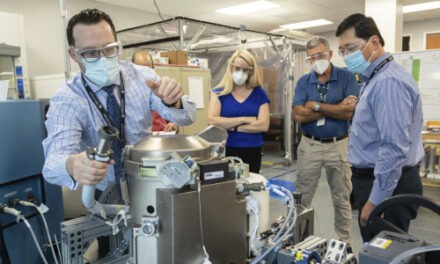By Bo Petersen
Kiawah Island, SC (AP) – They were Charleston friends on summer break from college who decided they wanted to spend the time figuring out how loggerhead sea turtle hatchlings find their way to the ocean.
Rhett Talbert Jr. and Tom McKee convinced the family who owned the remote, largely unpopulated Kiawah Island to let them out there, won a small state grant to study loggerhead turtle nesting and borrowed a Jeep to ride the beach.
Their techniques had flaws, later research would show. But that lark of a project in 1972 was maybe the most striking of a number of impromptu efforts by beachgoers that evolved into turtle patrols. The patrollers today are the hands-on heroes of a remarkable recovery.
This year, more than 1,500 volunteers took part among 35 turtle groups patrolling more than 120 miles of nesting beaches. A record was set for nests and hatchlings. The threatened-species loggerhead, considered to have been in decline, appears to have turned the corner in South Carolina waters.
“We think the reason for the high numbers this season were the result of the conservation efforts we put in place over 25 years ago,’’ said Lynne Sager, the permit holder, or leader, for the town of Kiawah Island Turtle Patrol.
The island group formed in 1977 after developers bought the island and wanted to promote the conservation work of Talbert and McKee. It was one of the earliest South Carolina volunteer patrols.
Predators:
The loggerhead is a 300 pound, 3-foot-long mammoth that crawls into the dunes each spring to lay eggs in nests that hatch over the summer. It’s one of seven sea turtle species around the world. All of the species are considered to be endangered or threatened, their numbers declining.
Six years before the turtle was declared a threatened species, Talbert and McKee, as well as a few beachfront residents along the coast, realized that most of the eggs or hatchlings were being lost to predators or storm tides. They began taking steps that turned a 10 percent survival-to-sea rate to nearly 60 percent.
Imitating techniques that were in use in Florida and Costa Rica, the two friends covered sites with protective mesh and moved some nests, two measures that were gradually refined by research biologists and now make up the core of protection work.
“The whole Endangered Species thing was brand new,’’ recalled Talbert, who now lives in Murrells Inlet. “We just knew there were nests on the island. We didn’t know how many, but we were pretty sure they were being disrupted by raccoons.’’
The island’s turtle patrol took up the work. Meanwhile residents on Fripp Island, school teacher Florence Johnston on Edisto Beach and people in other beachfront communities began to shepherd nests.
At times, the early days of sea turtle nest patrols weren’t much more than than a Wild West show.
A volunteer on Fripp near Beaufort allegedly “was going out on the beach at night, threatening people with a pistol and ordering them off the beach so they wouldn’t disturb the turtles,’’ DNR biologist Sally Murphy, now retired, wrote in “Turning the Tide,’’ her memoir published earlier this year.
People were, during the day, digging up the nests that were about to hatch, putting the eggs in buckets so schoolchildren could watch, then carrying the hatchlings to the surf where hungry gulls circled overhead. (The turtles hatch at night to protect them from predators and so they can orient to sea by the light glowing off the ocean.)
It wasn’t far removed from an earlier era when the eggs were dug up by beachgoers as a delicacy and onlookers took occasional rides on the shell of an exhausted loggerhead trying to make her way back to the surf after laying a nest.
Gradually, though, the “turtle ladies’’ (nearly all were women, leading to the popular nickname) took over, working with biologists to get it right.
In 1981, a few of them approached Murphy, wanting to use techniques like meshing and relocation, which would violate federal law without a permit. Murphy was working on how to improve turtle numbers with measures like excluder devices on shrimp boats that protected adults.
“Tides, ghost crabs, raccoons, they asked to be allowed to protect the nests,’’ Murphy said of the early volunteers.
DNR launched community sea turtle patrols with permits and strict protocols.
Marge Millman began keeping watch on nests in front of her Isle of Palms home in the early 1990s.
“The first year it was just me. It was a lot of walking. It was a lot of digging, a lot of transferring nests, restacking the eggs in the order they came out,’’ said Millman, who now lives in Lexington. “Little by little, people became interested.’’
Recovery:
More than a half-million loggerhead sea turtle hatchlings made their way from nests to the ocean in South Carolina this year, a preliminary figure of 525,540.
The hatch dwarfs any recent year on record. For comparison, 2016, the previous record nesting year, had 396,441 hatchlings emerge.
More females are coming in to nest in recent years and are believed to be breeding-age adults born in the 1980s when the more stringent nest protection was getting underway.
During that decade, about a half-million hatchlings crawled to the sea from S.C. nests. In the years since, more than 10 times that number have made the crawl. In the past 10 years alone, more than 2.5 million hatchlings emerged, according to DNR estimates.
Then came this year, matching the hatch of the entire first decade. All but 24 of the nests were loggerheads, the predominant nesting species here.
The hatches this year came despite hundreds of nests being lost to overwash from recurrent flood tides and Hurricane Dorian. They are the latest sign that the threatened species has turned the corner on recovery, at least locally.
Any number of researchers and people in the field are responsible. Murphy’s work has been honored nationally and internationally. In the Cape Romain National Wildlife Refuge, U.S. Fish and Wildlife biologists have been researching turtles since 1939.
But the turtle patrols are in a class of their own. On Kiawah alone, 257 people took part in patrols that protected 611 nests this year. Many of the groups are full and have a waiting list of people who want to take part in the crack-of-dawn effort.
The patrols previously worked with biologists to lead a “lights out’’ movement in beach communities, mandating beach-visible lighting be turned off or shaded at night during nesting season to keep from disorienting hatchlings. Lights out became state law in 1992.
Even lighting for the Arthur Ravenel Jr. Bridge over the Cooper River in Charleston Harbor now is dimmed.
“They’re huge,’’ Murphy said about the groups. “They do a lot more because they’re out there on the developed beaches. They’re not just doing nest protection, they’re doing outreach and education. To me, that’s as important a service as protecting the nests.’’
Loggerhead Sea Turtle
Loggerhead Sea Turtle Hatchling
Nesting Loggerhead Sea Turtle










